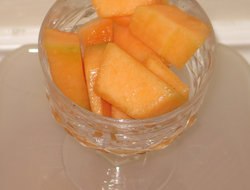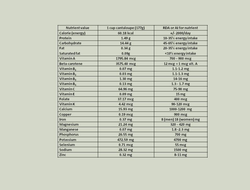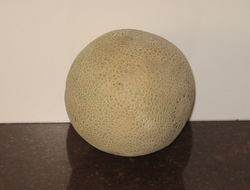Cantaloupe
Published: April 01, 2022
Cantaloupe is a popular fruit throughout the world.
Cantaloupe is a good source of carbohydrate, fibre, beta-carotene, potassium, and several vitamins and minerals.
The amount of beta-carotene in a one cup serving of cantaloupe is quite significant.
Beta-carotene is converted in your body to form vitamin A.
Vitamin A is required for several important processes in your body, such as vision, protein synthesis, cell differentiation, and reproduction and growth.
Beta carotene is also an antioxidant which may protect your body against several diseases such as cancer and heart disease.
Cantaloupe also contains other carotenoids: lutein, zeaxanthin and cryptoxanthin which are thought to protect against disease.
A one cup serving of cantaloupe provides about 10% of the recommended amount of potassium.
Potassium maintains your body's fluid and electrolyte balance, cell integrity, and is required from many reactions such as nerve impulse transmission and muscle contraction.
Most people do not meet their daily requirement for potassium. Consuming a serving of cantaloupe as part of your daily food intake will help you meet your potassium requirement.
Diets which are high in potassium and low in sodium are associated with a decreased risk of hypertension (high blood pressure).
Cantaloupe also contains a significant amount of vitamin C.
Like beta-carotene, vitamin C is an antioxidant and may protect against several cancers, as well as being a cofactor in collagen synthesis.
Collagen is the structural protein of connective tissue such as tendons and ligaments and also the foundation of bones and teeth.
Vitamin C is also involved in a variety of other metabolic reactions which occur in your body.
1 cup of cantaloupe can provide you with almost 10% of your daily requirement for folate another important water soluble vitamin which is required for DNA synthesis.
Click on the Cantaloupe nutrient information picture to enlarge the table. and learn about the nuitrients in a one cup serving of Cantaloupe.
History and use of cantaloupe
Cantaloupe is of the family Cucurbitaceae and is also known as canteloupe, cantaloup, mushmelon, musk melon, rock melon, sweet melon, Persian melon and spanspek.
Other members of the Cucurbitaceae plant family include gourds, cucumber, squashes, luffahs, melons and water melons.
The flesh of the cantaloupe is, in general, orange and the outer skin may have a "netted" look and feel to it.
European cultivated cantaloupes do not usually have a netted appearance, but may have a ribbed skin.
The skin of the European cantaloupe is grey/green unlike that of the North American cantaloupe which is brownish. Some varieties of cantaloupe have reddish flesh.
Cantaloupe is most commonly eaten fresh, but can be included in various salads, in desserts or as part of an appetiser.
Select cantaloupes which have clean skins that are free from bruises and cuts. A ripe and juicy cantaloupe will feel heavy for its size.
The skin of cantaloupe may be contaminated with harmful bacteria, such as Salmonella, and should be washed thoroughly before preparation begins.
Cutting an unwashed cantaloupe may transfer harmful bacteria from the skin to the flesh of the fruit.
Once cut, cantaloupe should be stored in the refrigerator, and eaten within a few days of being cut to reduce the risk of growth of potentially harmful bacteria.
Cantaloupe are sometimes treated after harvest with a wash containing bleach or sodium hypochorite to prevent bacterial and mold growth during transport and storage.
Originating in Africa, India and Iran, the cantaloupe was first cultivated 5000 years ago in Iran and 4000 years ago in Egypt and Greece.
Cultivation of the fruit spread to Europe, North America and Mexico several hundred years ago. Cantaloupes grow best under warm tropical-like conditions and have a fairly long growing season.
In cooler climates the plants may be started off under glass before being transplanted outdoors.
References
1.
Whitney, E. & Rady Rolfes, S. (2005). Understanding Nutrition. Belmont, CA: Thomson Wadsworth
2.
Gropper, S.S., Smith, J.L. & Groff, J.L. (2005). Advanced Nutrition and Human Metabolism (4thEd.). Belmont, CA: Thomson Wadsworth.
4.



